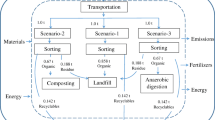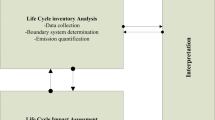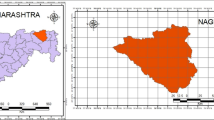Abstract
The goal of this study is to use life cycle assessment (LCA) tool to assess possible environmental impacts of different municipal solid waste management (MSWM) scenarios on various impact categories for the study area Dhanbad City, India. The scenarios included in the present study are collection and transportation (denoted as S1); baseline scenario consisting of recycling, open burning, open dumping, and finally unsanitary landfilling without energy recovery (denoted by S2); composting and landfilling (denoted by S3); and recycling and composting followed by landfilling of inert waste without energy recovery (denoted by S4). One ton of municipal solid waste (MSW) was selected as the functional unit. The primary data were collected through sampling, surveys, and literatures. Background data were obtained from Eco-invent data of SimaPro 8.1 libraries. The scenarios were compared using the CML 2 baseline 2000 method, and the results indicated that the scenario S1 had the highest impact on marine aquatic ecotoxicity (1.86E + 04 kg 1,4-DB eq.) and abiotic depletion (2.09E + 02 kg Sb eq.). S2 had the highest impact on global warming potential (9.42E + 03 kg CO2 eq.), acidification (1.15E + 01 kg SO2 eq.), eutrophication (2.63E + 00 kg PO4 3− eq.), photochemical oxidation (2.12E + 00 kg C2H4 eq.), and human toxicity (2.25E + 01 kg 1,4-DB eq.). However, S3 had the highest impact on abiotic depletion (fossil fuels) (2.71E + 02 MJ), fresh water aquatic ecotoxicity (6.54E + 00 kg 1,4-DB eq.), terrestrial ecotoxicity (3.36E − 02 kg 1,4-DB eq.), and ozone layer depletion (2.73E − 06 kg CFC-11 eq.). But S4 did not have the highest impact on any of the environmental impact categories due to recycling of packaging waste and landfilling of inert waste. Landfilling without energy recovery of mixed solid waste was found as the worst disposal alternative. The scenario S4 was found as the most environmentally suitable technology for the study area and recommended that S4 should be considered for strategic planning of MSWM for the study area.










Similar content being viewed by others
References
Abduli MA, Naghib A, Yonesi M, Akbari A (2011) Life cycle assessment (LCA) of solid waste management strategies in Tehran: landfill and composting plus landfill. Environ Monit Assess 178:487–498
Al-Khatib IA, Monou M, Salam AF, Hafez AQ, Shaheen KD (2010) Solid waste characterization, quantification and management practices in developing countries. A case study: Nablus district-Palestine. J Enviro Manag 91:1131–1138
American Society of Testing and Materials (ASTM), 2003. Standard test methods for determination of the composition of unprocessed municipal solid waste. D 5231–92
Andersen JK, Boldrin A, Samuelsson J, Christensen TH, Scheutz C (2010) Quantification of greenhouse gas emissions from windrow composting of garden waste. J Environ Qual 39(2):713–724
Arena U, Mastellone ML, Perugini F (2003) The environmental performance of alternative solid waste management options: a life cycle assessment study. Chem Eng J 96:207–222
Aymard V, Botta-Genoulaz V (2017) Normalisation in life-cycle assessment: consequences of new European factors on decision-making. Supply Chain Forum: An International Journal 18(2):76–83
Babu GS, Lakshmikanthan P, Santhosh LG (2014) Life cycle analysis of municipal solid waste (MSW) land disposal options in Bangalore City. In ICSI 2014: Creating infrastructure for a sustainable world 795–806. Am Soc Civil Eng. https://doi.org/10.1061/9780784478745.075
Banar M, Cokaygil Z, Ozkan A (2009) Life cycle assessment of solid waste management options for Eskisehir Turkey. Waste Manag 29:54–62
Bauman H, Tillman A (2004) The hitch hiker’s guide to LCA. Student literature AB, Stockholm
Beigl P, Salhofer S (2004) Comparison of ecological effects and costs of communal waste management systems. Resour Conserv Recycl 41:83–102
Bohra A, Nema AK, Ahluwalia P (2012) Global warming potential of waste management options: case study of Delhi. Int J Environ Technol Manag 15(3–6):346–362
Buttol P, Masoni P, Bonoli A, Goldoni S, Belladonna V, Cavazzuti C (2007) LCA of integrated MSW management systems: case study of the Bologna district. Waste Manag 27:1059–1070
Cabaraban MTI, Khire MV, Alocilja ECC (2008) Aerobic in-vessel composting versus bioreactor landfilling using life cycle inventory models. Clean Techn Environ Policy 10:1–39
Census of India (2011) Ministry of Home Affairs. Government of India, New Delhi <http://censusindia.gov.in/2011-common/censusdataonline.html> (accessed 03.02.2015)
Cherubini F, Bargigli S, Ulgiati S (2008) Life cycle assessment of urban waste management: energy performances and environmental impacts. The case of Rome, Italy. Waste Manag 28(12):2552–2564
CPHEEO (2016) Ministry of urban development, central public health and environmental engineering organization, ministry of urban development, Government of India, www.swachhbharaturban.gov.in. (assessed 16/08/ 2017)
Dong J, Chi Y, Zou D, Fu C, Huang Q, Ni M (2014) Comparison of municipal solid waste treatment technologies from a life cycle perspective in China. Waste Manag Res 32(1):13–23
EPA (1995) Compilation of air pollution emission factors, volume I: stationary point and area sources, fifth edition, AP-42 (GPO 055–000–00500-1). U.S. Environmental Protection Agency, Research Triangle Park, North Carolina
EPA (1997) Evaluation of emissions from the open burning of household waste in barrels. EPA-600/R-97-134a. U.S. Environmental Protection Agency, Control Technologies Center, Research Triangle Park, North Carolina
Eriksson O, Carlsson Reich M, Frostell B, Bjorklund A, Assefa G, Sundqvist JO (2005) Municipal solid waste management from a systems perspective. J Clean Prod 13:241–252
Goedkoop M, Oele M, Effting S (2004) Simapro Database Manual Methods Library. Pre Constultants, Netharlands
Hao X, Chang C, Larney FJ, Greg RT (2001) Greenhouse gas emissions during cattle feedlot manure composting. J Environ Qual 30:376–386
Hauschild M, Wenzel H (1998) Environmental assessment of products. In: scientific background, vol. 2. Chapman & Hall, Institute for product development, Technical University of Denmark
Hong RJ, Wang GF, Guo RZ, Cheng X, Liu Q, Zhang PJ, Qian GR (2006) Life cycle assessment of BMT-based integrated municipal solid waste management: case study in Pudong, China. Resour Conserv Recycl 49:129–146
Hong J, Li X, Zhaojie C (2010) Life cycle assessment of four municipal solid waste management scenarios in China. Waste Manag 30(11):2362–2369
Huijbregts MAJ, Breedveld L, Huppes G, de Koning A, van Oers L, Suh S (2003) Normalisation figures for environmental life-cycle assessment: The Netherlands (1997/1998), Western Europe (1995) and the world (1990 and 1995). J Clean Prod 11(7):737–748
Jackel U, Thummes K, Kämpfer P (2005) Thermophilic methane production and oxidation in compost. FEMS (Federation of European Microbiological Societies) Microbiol Ecol 52:175–184
Karoneas CJ, Nanaki EA (2012) Integrated solid waste management and energy production a life cycle assessment approach: the case study of the city of Thessaloniki. J Clean Prod 27:141–150
Kebin HE, Zhiliang Y, Zhang Y (2010) Characteristics of vehicle emissions in China based on portable emission measurement system. 19th Annual International Emission Inventory Conference “Emissions Inventories Informing Emerging Issues”, San Antoni
Khan D, Kumar A, Samadder SR (2016) Impact of socioeconomic status on municipal solid waste generation rate. Waste Manag 49:15–25
Komilis DP, Ham RK (2004) Life-cycle inventory of municipal solid waste and yard waste windrow composting in the United States. J Environ Eng 130(11):1390–1400
Korhonen MR, Dahlbo H (2007) Reducing greenhouse gas emissions by recycling plastics and textiles into products. https://dspace3.hulib.helsinki.fi/bitstream/handle/10138/38425/FE_30_2007.pdf?sequence=3. Accessed 18 Oct 2017
Liamsanguan C, Gheewala SH (2008) LCA: a decision support tool for environmental assessment of MSW management systems. J Environ Manag 87(1):132–138
Mboowa D, Quereshi S, Bhattacharjee C, Tonny K, Dutta S (2017) Qualitative determination of energy potential and methane generation from municipal solid waste (MSW) in Dhanbad (India). Energy 123:386–391
Mendes MR, Aramaki T, Hanaki K (2004) Comparison of the environmental impact of incineration and landfilling in Sao Paulo City as determined by LCA. Resour Conserv Recycl 41:47–63
Menikpura SNM, Gheewala SH, Bonnet S, Chiemchaisri C (2013) Evaluation of the effect of recycling on sustainability of municipal solid waste management in Thailand. Waste Biomass Valoriz 4(2):237–257
Miliute J, Kazimieras Staniskis J (2010) Application of life-cycle assessment in optimization of municipal waste management systems: the case of Lithuania. Waste Manag Res 28:298–308
Ozeler D, Yetis U, Demirer GN (2006) Life cycle assessment of municipal solid waste management methods: Ankara case study. Environ Int 32:405–411
Peavy HS, Rowe DR, Techobanoglous G (1985) Environmental Engineering PP-579. Mc-Graw-Hill, International Edition, New York
POC “Population of Cities in” (2017) http://worldpopulationreview.com/countries/india-population/cities/. 3 may 2017
PRé, Consultants. “SimaPro Database Manual Methods Library.” PRé Consultants (2008)
Rajaeifar MA, Tabatabaei M, Ghanavati H, Khoshnevisan B, Rafiee S (2015) Comparative life cycle assessment of different municipal solid waste management scenarios in Iran. Renew Sust Energ Rev 51:886–898
Rajcoomar A, Ramjeawon T (2017) Life cycle assessment of municipal solid waste management scenarios on the small island of Mauritius. Waste Manag Res 35(3):313–324
Ramos MC, López-Acevedo M (2004) Zinc levels in vineyard soils from the Alt Penedès-Anoia region (NE Spain) after compost application. Adv Environ Res 8(3):687–696
Ray MR, Roy Choudhury S, Mukherjee G, Roy S, Lahiri T (2005) Respiratory and general health impairments of workers employed in a municipal solid waste disposal at open landfill site in Delhi. Int J Hyg Environ Health 108(4):255–262
Saft RJ, Elsinga W (2006) Source separation, composting a win for greenhouse gas reduction. Bio Cycle 47(8):50–53
Saheri S, Mir MA, Basri NEA, Mahmood NZB, Begum RA (2012) Life cycle assessment for solid waste disposal options in Malaysia. Pol J Environ Stud 21:1377–1382
Samadder SR, Prabhakar R, Khan D, Kishan D, Chauhan MS (2017) Analysis of the contaminants released from municipal solid waste landfill site: a case study. Sci Total Environ 580:593–601
Sharma BK, Chandel MK (2017) Life cycle assessment of potential municipal solid waste management strategies for Mumbai, India. Waste Manag Res 35(1):79–91
Sharma M, McBean EA (2007) Methodology for solid waste characterization based on diminishing marginal returns. Waste Manag 27:337–344
Song Q, Wang Z, Li J (2013) Environmental performance of municipal solid waste strategies based on LCA method: a case study of Macau. J Clean Prod 57:92–100
Srivastava AK, Nema AK (2011) Life cycle assessment of integrated solid waste management system of Delhi. In: Finkbeiner M (ed) Towards life cycle sustainability management. Springer, Dordrecht, pp 267–276
Tan RBH, Khoo HH (2006) Impact assessment of waste management options in Singapore. J Air Waste Manage Assoc 56:244–254
Tarantini M, Loprieno AD, Cucchi E, Frenquellucci F (2009) Life cycle assessment of waste management systems in Italian industrial areas: case study of 1st Macrolotto of Prato. Energy 34:613–622
Tchobanoglous G, Hilar T, Samuel AV (1993) Integrated solid waste management-engineering principles and management issues. Tata McGraw Hill International Edition, New Delhi, pp 382–383
UNEP (2011) Towards a green economy: pathways to sustainable development and poverty eradication. United Nations Environment Programme (UNEP), Nairobi
World Bank (2012) What a waste a global review of solid waste management. Urban Development Series Knowledge Paper No. 15, Washington, DC
Yadav P, Samadder SR (2017a) Assessment of applicability index for better management of municipal solid waste: a case study of Dhanbad, India. Environ Technol. https://doi.org/10.1080/09593330.2017.1332104
Yadav P, Samadder SR (2017b) A global prospective of income distribution and its effect on life cycle assessment of municipal solid waste management: a review. Environ Sci Pollu Res 24(10):9123–9141
Yay ASE (2015) Application of life cycle assessment (LCA) for municipal solid waste management: a case study of Sakarya. J Clean Prod 94:284–293
Zaman AU (2010) Comparative study of municipal solid waste treatment technologies using life cycle assessment method. Environ Sci Technol 7(2):225–234
Zhao Y, Wang H, Lu W, Damgaard A, Christensen TH (2009) Life-cycle assessment of the municipal solid waste management system in Hangzhou, China (EASEWASTE). Waste Manag Res 27:399–406
Zhen-Shan L, Lei Y, Xiao-Yan Q, Yu-Mei S (2009) Municipal solid waste management in Beijing City. Waste Manag 29(9):2596–2599
Acknowledgments
The authors acknowledge the support provided by the Department of Environmental Science and Engineering, Indian Institute of Technology (Indian School of Mines), Dhanbad, for carrying out this research work.
Author information
Authors and Affiliations
Corresponding author
Additional information
Responsible editor: Philippe Garrigues
Rights and permissions
About this article
Cite this article
Yadav, P., Samadder, S.R. Environmental impact assessment of municipal solid waste management options using life cycle assessment: a case study. Environ Sci Pollut Res 25, 838–854 (2018). https://doi.org/10.1007/s11356-017-0439-7
Received:
Accepted:
Published:
Issue Date:
DOI: https://doi.org/10.1007/s11356-017-0439-7




